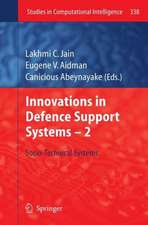Radial Basis Function Networks 2: New Advances in Design: Studies in Fuzziness and Soft Computing, cartea 67
Autor Robert J. Howlett, Lakhmi C. Jainen Limba Engleză Hardback – 27 mar 2001
| Toate formatele și edițiile | Preț | Express |
|---|---|---|
| Paperback (1) | 991.27 lei 6-8 săpt. | |
| Physica-Verlag HD – 27 mar 2011 | 991.27 lei 6-8 săpt. | |
| Hardback (1) | 997.71 lei 6-8 săpt. | |
| Physica-Verlag HD – 27 mar 2001 | 997.71 lei 6-8 săpt. |
Din seria Studies in Fuzziness and Soft Computing
- 20%
 Preț: 999.85 lei
Preț: 999.85 lei - 20%
 Preț: 653.06 lei
Preț: 653.06 lei - 20%
 Preț: 872.96 lei
Preț: 872.96 lei - 20%
 Preț: 930.57 lei
Preț: 930.57 lei - 20%
 Preț: 1051.00 lei
Preț: 1051.00 lei - 20%
 Preț: 992.44 lei
Preț: 992.44 lei - 20%
 Preț: 655.85 lei
Preț: 655.85 lei - 20%
 Preț: 1001.86 lei
Preț: 1001.86 lei - 18%
 Preț: 954.14 lei
Preț: 954.14 lei - 20%
 Preț: 330.10 lei
Preț: 330.10 lei - 20%
 Preț: 333.04 lei
Preț: 333.04 lei - 20%
 Preț: 997.56 lei
Preț: 997.56 lei -
 Preț: 391.61 lei
Preț: 391.61 lei - 20%
 Preț: 647.79 lei
Preț: 647.79 lei - 20%
 Preț: 986.01 lei
Preț: 986.01 lei - 18%
 Preț: 958.56 lei
Preț: 958.56 lei - 20%
 Preț: 996.40 lei
Preț: 996.40 lei - 20%
 Preț: 999.35 lei
Preț: 999.35 lei - 15%
 Preț: 646.43 lei
Preț: 646.43 lei - 20%
 Preț: 651.57 lei
Preț: 651.57 lei - 20%
 Preț: 997.89 lei
Preț: 997.89 lei - 15%
 Preț: 641.03 lei
Preț: 641.03 lei - 20%
 Preț: 1009.74 lei
Preț: 1009.74 lei - 20%
 Preț: 992.62 lei
Preț: 992.62 lei -
 Preț: 388.72 lei
Preț: 388.72 lei - 18%
 Preț: 1223.43 lei
Preț: 1223.43 lei - 20%
 Preț: 651.42 lei
Preț: 651.42 lei - 18%
 Preț: 951.59 lei
Preț: 951.59 lei - 18%
 Preț: 948.61 lei
Preț: 948.61 lei
Preț: 997.71 lei
Preț vechi: 1247.14 lei
-20% Nou
Puncte Express: 1497
Preț estimativ în valută:
190.91€ • 199.86$ • 157.97£
190.91€ • 199.86$ • 157.97£
Carte tipărită la comandă
Livrare economică 05-19 aprilie
Preluare comenzi: 021 569.72.76
Specificații
ISBN-13: 9783790813685
ISBN-10: 3790813680
Pagini: 384
Ilustrații: XIX, 360 p.
Dimensiuni: 155 x 235 x 26 mm
Greutate: 0.71 kg
Ediția:2001
Editura: Physica-Verlag HD
Colecția Physica
Seria Studies in Fuzziness and Soft Computing
Locul publicării:Heidelberg, Germany
ISBN-10: 3790813680
Pagini: 384
Ilustrații: XIX, 360 p.
Dimensiuni: 155 x 235 x 26 mm
Greutate: 0.71 kg
Ediția:2001
Editura: Physica-Verlag HD
Colecția Physica
Seria Studies in Fuzziness and Soft Computing
Locul publicării:Heidelberg, Germany
Public țintă
ResearchCuprins
1. An overview of radial basis function networks.- 2. Using radial basis function networks for hand gesture recognition.- 3. Using normalized RBF networks to map hand gestures to speech.- 4. Face recognition using RBF networks.- 5. Classification of facial expressions with domain Gaussian RBF networks.- 6. RBF network classification of ECGs as a potential marker for sudden cardiac death.- 7. Biomedical applications of radial basis function networks.- 8. 3-D visual object classification with hierarchical radial basis function networks.- 9. Controller applications using radial basis function networks.- 10. Model-based recurrent neural network for fault diagnosis of nonlinear dynamic systems.- List of contributors.
Textul de pe ultima copertă
The Radial Basis Function (RBF) neural network has gained in popularity over recent years because of its rapid training and its desirable properties in classification and functional approximation applications. RBF network research has focused on enhanced training algorithms and variations on the basic architecture to improve the performance of the network. In addition, the RBF network is proving to be a valuable tool in a diverse range of application areas, for example, robotics, biomedical engineering, and the financial sector. The two volumes provide a comprehensive survey of the latest developments in this area. Volume 2 contains a wide range of applications in the laboratory and case studies describing current industrial use. Both volumes will prove extremely useful to practitioners in the field, engineers, reserachers, students and technically accomplished managers.
Caracteristici
Contains a wide range of applications in the laboratory and case studies describing current use Overall view of the methods used for the genetic optimization of artificial neural networks and presentation of the inherent problems Includes supplementary material: sn.pub/extras























